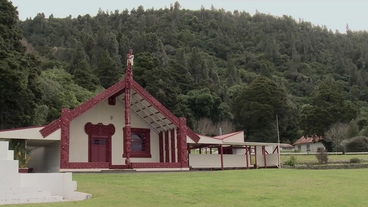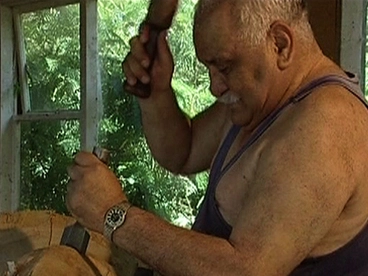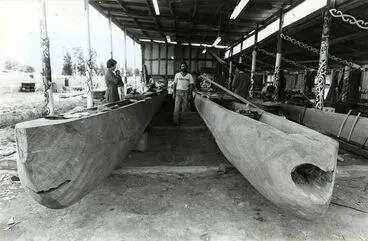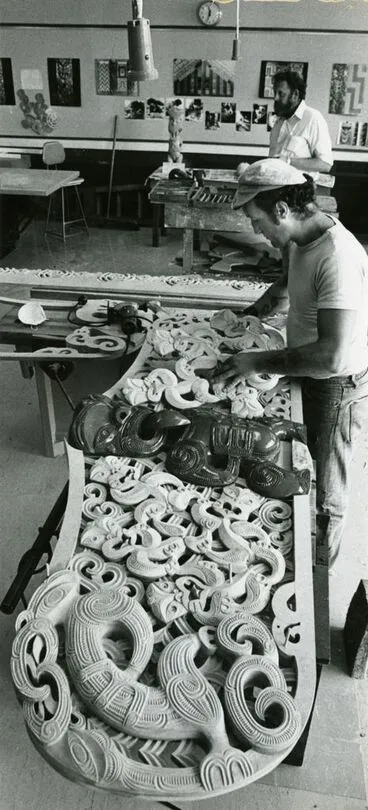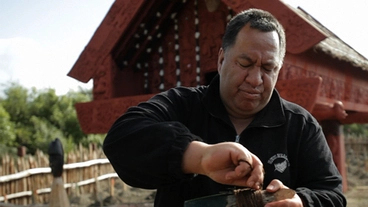Māori weavers and carvers
A DigitalNZ Story by National Library Services to Schools
This story provides links to resources about some of New Zealand's tohunga raranga and tohunga whakairo (expert weavers and carvers).
Beautiful and rare example of a kete tāniko (a bag with fine embroidery or weaving in a geometric pattern).
Museum of New Zealand Te Papa Tongarewa
RARANGA - WEAVING
Taonga such as kākahu (cloaks or garments) connect to the spiritual world through the whakapapa of the natural materials from which they are woven, the values and ancestral knowledge and practices. According to Ngāti Awa elder Hāmiora Pio, the knowledge of weaving began with Hine-rauamoa, the wife of Tāne-nui-a-rangi.
This whakataukī (saying) illustrates how important a weaver was to her community in the past. From birth, a girl of aristocratic lineage was initiated into the arts of Hine-rauamoa.
Muka, the inner fibre extracted from the long, sword-like leaves of the harakeke (New Zealand flax), is the preferred customary fibre for cloak weaving. Careful observation of protocols and rituals protected the mauri (life force) of the plants and material harvested for weaving, and the mauri of the weaver herself.
A well-known weaver gave mana to taonga (ancestral treasures) they created through their own personal skills and knowledge. Mastery of weaving involves many skills, from making baskets, cords and mats to fine cloaks, using processes and techniques developed over many generations. The most prized items were carefully and beautifully made for important people. These taonga increase in cultural value with each passing generation.
Source: Māori clothing and adornment – kākahu Māori - Weaving traditions and technique, Te Ara - the Encyclopedia of New Zealand
Te Rito
Manatū Taonga, the Ministry for Culture and Heritage
DAME RANGIMĀRIE HETET (NGĀTI MANIAPTO)
Dame Rangimārie Hetet was an expert weaver who passed on her skills to numerous women in New Zealand, including her daughter, Diggeress Te Kanawa, herself a well-known weaver. Rangimārie Hetet continued to practise her craft until her death at the age of 103.
Source: Ngāti Maniapoto - Ngāti Maniapoto today, Te Ara - the Encyclopedia of New Zealand
Rangimārie Hetet
Manatū Taonga, the Ministry for Culture and Heritage
DAME RANGIMĀRIE HETET
Our Wāhine
DIGGERESS TE KANAWA (NGĀTI MANIAPOTO)
A number of dedicated women sustained the weaving arts and passed them on to younger female relatives. Perhaps the most significant was Diggeress Te Kanawa (of Ngāti Maniapoto and Ngāti Kinohaku), the daughter of another renowned weaver, Dame Rangimarie Hetet. Te Kanawa took part in hui in the 1950s hosted by the Maori Women’s Welfare League to promote whāriki-making and other weaving traditions. For the next 50 years she remained at the forefront of the promotion and revival of Māori weaving. Te Kanawa was a founding member of Aotearoa Moananui a Kiwa Weavers, later Te Roopu Raranga Whatu o Aotearoa, the National Māori Weavers Collective of New Zealand. She received many awards for her work, including a CNZM in 2000 and an honorary doctorate in 2007.
Source: Te raranga me te whatu - Revival of Māori fibre work, Te Ara - the Encyclopedia of New Zealand
DIGGERESS TE KANAWA
Our Wāhine
Kete huruhuru / feathered bag
Waikato Museum Te Whare Taonga o Waikato
Diggeress Te Kanawa
Manatū Taonga, the Ministry for Culture and Heritage
EMILY RANGITIARIA SCHUSTER (TE ARAWA)
A sustained revival of weaving traditions began in 1969, when a national weaving school, Te Rito, was established at Rotorua, alongside the existing national carving school. The first head of Te Rito was Emily Schuster. Te Rito trains students in the art and skills of traditional weaving either through a full-time three-year course, or in part-time community-based courses. Students are taught the skills of the art form, the traditions and tikanga (protocols) and the stories and designs unique to each iwi. Traditional Māori weaving is also taught in tertiary and other educational institutions.
Source: Te raranga me te whatu - Revival of Māori fibre work, Te Ara - the Encyclopedia of New Zealand
Craft New Zealand - Emily Schuster and Donna Waiariki
Museum of New Zealand Te Papa Tongarewa
Nga Tāonga korero - Emily Schuster
Radio New Zealand
Bodice underskirt with tāniko design
New Zealand Fashion Museum
DONNA WAIARIKI
Kahurangi: Emily Schuster and Donna Waiariki. Portrait
Museum of New Zealand Te Papa Tongarewa
Hieke (rain cape)
Museum of New Zealand Te Papa Tongarewa
Craft New Zealand - Emily Schuster and Donna Waiariki
Museum of New Zealand Te Papa Tongarewa
ERENORA PUKETAPU-HETET (TE ĀTI AWA)
Erenora Puketapu-Hetet (Te Āti Awa) grew up in Waiwhetū in the Hutt Valley. Her husband, master carver Rangi Hetet, was the grandson of renowned traditional weaver Rangimārie Hetet. Puketapu-Hetet learned cloak-weaving from Rangimārie, and passed on her knowledge to her children and many others through books and weaving workshops. She became famous for innovations on traditional techniques and designs, incorporating materials such as fuse wire and pāua shell. Since 1996 important visitors to the Museum of New Zealand Te Papa Tongarewa have worn a kahu kiwi (kiwi feather cloak) made by Puketapu-Hetet. In 2002 she was made an Officer of the New Zealand Order of Merit for services to weaving. She died in 2006.
Source: Te raranga me te whatu - Kākahu – woven cloaks, Te Ara - the Encyclopedia of New Zealand
Kete muka (bag)
Museum of New Zealand Te Papa Tongarewa
Kahurangi: Erenora Hetet. Portrait
Museum of New Zealand Te Papa Tongarewa
Kahu kiwi (kiwi feather cloak)
Museum of New Zealand Te Papa Tongarewa
VERANOA HETET (NGĀTI TŪWHARETOA, NGĀTI MANIAPOTO, TE ĀTI AWA)
It's in the Genes Girls
NZ On Screen
Veranoa Hetet
Radio New Zealand
RANUI NGARIMU (KAI TAHU)
Rau Whakapapa by Ranui Ngarimu and Areta Wilkinson
Christchurch City Libraries
New Year Honours: Ranui Ngarimu
Radio New Zealand
Detail of harakeke and muka, Rau Whakapapa by Ranui Ngarimu and Areta Wilkinson
Christchurch City Libraries
KIRI NATHAN (KAI TAHU)
Putiputi flower lace dress
New Zealand Fashion Museum
Māori fashion designer Kiri Nathan not willing to conform
Radio New Zealand
WHAKAIRO - CARVING
Legendary origins of carving
According to legend, carving was discovered by Ruatepupuke when rescued his son, Manuruhi, from the carved underwater village of Tangaroa, the god of the sea.
Carving materials and techniques
The wood used for carving symbolised Tāne, the god of the forest. When carved it was considered to take on the properties of the figures it represented.
Stone or greenstone adzes and chisels were traditionally used in carving. After Europeans brought metal to New Zealand, carvers began to use sharper metal tools.
There were rituals and rules around carving, for example wood chips could not be used as fuel for a cooking fire.
A carver was expected to spend up to 20 years learning about all aspects of carving.
Source: Whakairo – Māori carving, Te Ara - the Encyclopedia of New Zealand
Carved gateway to the Whakarewarewa Model Village
Auckland Libraries
The Rotorua school
The Ngāti Tarāwhai hapū of Te Arawa had renowned carvers, including Wero Tāroi. He lived in Rotorua, which was a popular tourist destination. The carving style was changed to please European tourists and patrons who bought the work.The Rotorua School of Māori Arts and Crafts was founded in 1926. It trained students in traditional carving. Through this programme, many carved meeting houses and dining halls were constructed around the country.
Source: Whakairo – Māori carving, Te Ara - the Encyclopedia of New Zealand
Temple View, Hamilton
Alexander Turnbull Library
WERO TĀROI (NGĀTI TARĀWHAI)
Ngāti Tarāwhai carver Wero Tāroi was perhaps the first to use steel chisels for carving. In the 1860s and 1870s he used this new technology to great effect, creating powerful sinuous figures on the maihi (bargeboards) and amo (front post) of his house Houmaitawhiti (1860). The surface patterning is boldly carved but complements rather than competes with the sculptural forms. As well as the free-flowing boldness in his designs, Wero introduced bicultural innovations, carving European riding boots onto his figures and decorating them with paint rather than traditional kōkōwai (red ochre). He transmitted his knowledge to his apprentices Ānaha Te Rāhui, Neke Kapua and Tene Waitere.
Source: Whakairo – Māori carving - The Rotorua school, Te Ara - the Encyclopedia of New Zealand
Nuku Te Apiapi meeting house at Whakarewarewa
Alexander Turnbull Library
Carved Mirror Frame
Museum of New Zealand Te Papa Tongarewa
PINEAMINE TAIAPA (NGĀTI POROU)
Pine Taiapa working on a wood carving
Alexander Turnbull Library
Pine Taiapa
Manatū Taonga, the Ministry for Culture and Heritage
ERAMIHA NEKE KAPUA & NEKE KAPUA (NGĀTI TARĀWHAI, TE ARAWA)
[Eramiha Neke, Tene Neke, Neke Kapua and Paoro]
Auckland War Memorial Museum Tāmaki Paenga Hira
Waharoa (gateway)
Museum of New Zealand Te Papa Tongarewa
Rotorua carvers - Neke Kapua (centre) and sons Tene Kapua (left) and Eramiha Neke Kapua
Museum of New Zealand Te Papa Tongarewa
RANGI HETET (NGĀTI TŪWHARETOA, NGĀTI MANIAPOTO)
Mo Te Iwi: Carving for the People
NZ On Screen
Ranginui, Papatūānuku and offspring
Manatū Taonga, the Ministry for Culture and Heritage
Waka taua
Manatū Taonga, the Ministry for Culture and Heritage
PAKAARIKI HARRISON (NGĀTI POROU)
He Tohunga Whakairo
NZ On Screen
Kennedys Bay, Coromandel, Harrison's place
Alexander Turnbull Library
Master carver Pakariki Harrison
Manatū Taonga, the Ministry for Culture and Heritage
ARNOLD MANAAKI WILSON (NGAI TŪHOE)
Arnold Wilson in his workshop at Bay of Islands College, Kawakawa
Alexander Turnbull Library
Mihaia te Tuatahi
Museum of New Zealand Te Papa Tongarewa
Arnold Wilson sculpture, 1964
Manatū Taonga, the Ministry for Culture and Heritage
WINIATA HARRISON (NGĀTI POROU)
Tohunga whakairo
Radio New Zealand
MATAHI WHAKATAKA-BRIGHTWELL
Carving the Hawaiki-nui
Manatū Taonga, the Ministry for Culture and Heritage
Ngātoroirangi
Manatū Taonga, the Ministry for Culture and Heritage
Ko Matahi Avauli Whakataka-Brightwell me te Waka Hawaiiki-nui, Pahiatua
Palmerston North City Library
CLIFF WHITING (TE WHĀNAU-Ā-APANUI)
Modern marae: Te Hono ki Hawaiki
Manatū Taonga, the Ministry for Culture and Heritage
Carving for Palmerston North Teachers' College Marae "Te Kupenga o Te Matauranga"
Palmerston North City Library
He Mātanga Toi - Dr Cliff Whiting
Radio New Zealand
LIONEL GRANT (TE ARAWA, NGĀTI PIKIAO)
Whare Māori - The Wharenui (Episode Two)
NZ On Screen
Waitūkei sculpture, Rotorua
Manatū Taonga, the Ministry for Culture and Heritage
2009 Laureates revealed
Radio New Zealand
This story was curated and compiled by Te Puna Mātauranga o Aotearoa | National Library of New Zealand, Services to Schools staff, November 2020.


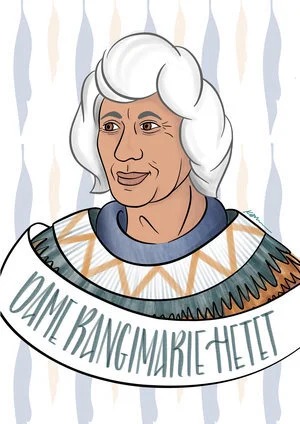
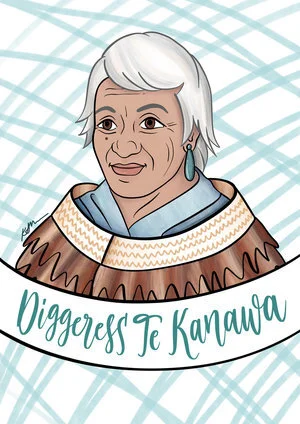
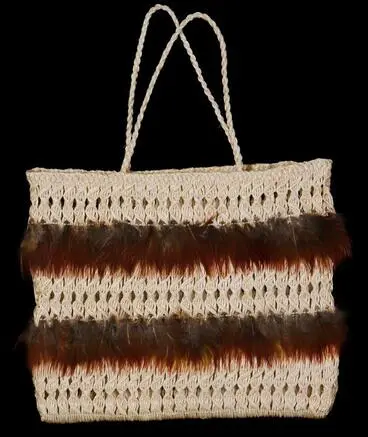



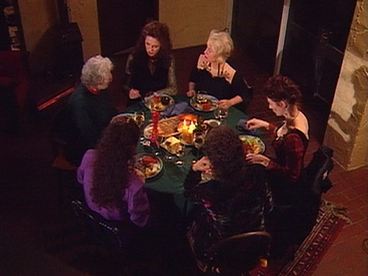


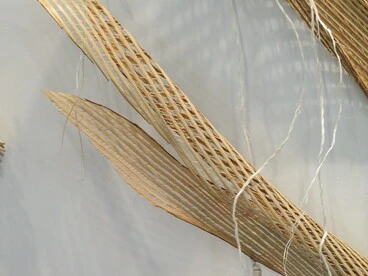

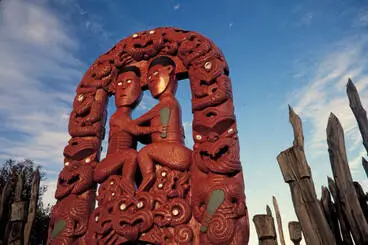
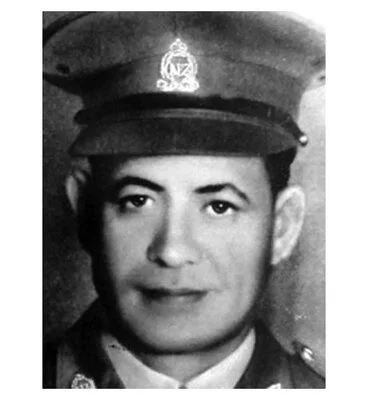
![[Eramiha Neke, Tene Neke, Neke Kapua and Paoro] Image: [Eramiha Neke, Tene Neke, Neke Kapua and Paoro]](https://thumbnailer.digitalnz.org/?resize=770x&src=https%3A%2F%2Fcollection-api.aucklandmuseum.com%2Frecords%2Fimages%2Fmedium%2F494301%2F5d54209e8dc9974f1b1e1a0bb88e0bb84cfbb2b1.jpg&resize=368%253E)
